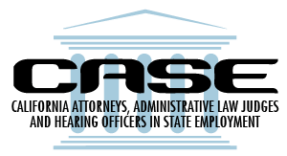Rollover madness continues. The CASE Bargaining Team and CalHR met again this week and dispatched with another set of rollover agreements that preserve existing elements of the MOU and reached agreement on several technical updates and not-too-exciting updates to language.
CASE is focused on the present and moving forward; CalHR seems stuck in the past. As mentioned in prior Bargaining Reports, CASE presented CalHR a comprehensive salary and benefit proposal on April 26 that would do the following:
- Account for the approximate 30% salary lag between Unit 2 attorneys and their local government peers.
- Account for the even greater salary lag between Unit 2 ALJs and their federal and other public employee peers.
- Address the impact of recent historic inflation.
- Create a structural solution to eliminate future salary disparities between Unit 2 and other public sector comparison classes.
- Create a meaningful paid family leave benefit so that Unit 2 employees can have the time they need to care for an ailing family member or welcome a new child into their homes.
- Recognize the value of preserving institutional knowledge by providing longevity pay to those with 17 or more years of state service.
- Align Unit 2 travel expense reimbursement rates with federal rates.
CalHR has yet to respond to or provide counterproposals to CASE’s main economic offers so far – instead repeatedly citing how complicated and how high our asks have been. Why does CalHR seem surprised by our numbers? It’s likely because time and again, CalHR has tried to rely on the past as precedent – they use CASE’s smaller prior raises as benchmarks. In doing so they ignore the world as it currently exists. The salary lag is real. Anyone can see it clearly. While understanding the history of CASE bargaining and prior MOUs is important, using that history to hamstring the future is simply not something the CASE Bargaining Team accepts – nor will you, our members, tolerate.
Vacancy Rates. CalHR asserts that there is no significant vacancy problem in Unit 2 because Unit 2 vacancy rates (according to CalHR, about 16.8%) are roughly in line with vacancy rates across the civil service (about 17.1%). When we look at those numbers, we see a state operating with significant staff shortages across the board – which should be deeply concerning to the Governor. We also hear every day from members telling us how many people are missing in their unit or section, how posted jobs draw zero applicants, and how few applicants take them up on job offers as they instead choose local jurisdictions. Help us better explain what the Unit 2 vacancy rate is and what it means by sharing your story here.
The parties return to the table Thursday, June 2nd.

